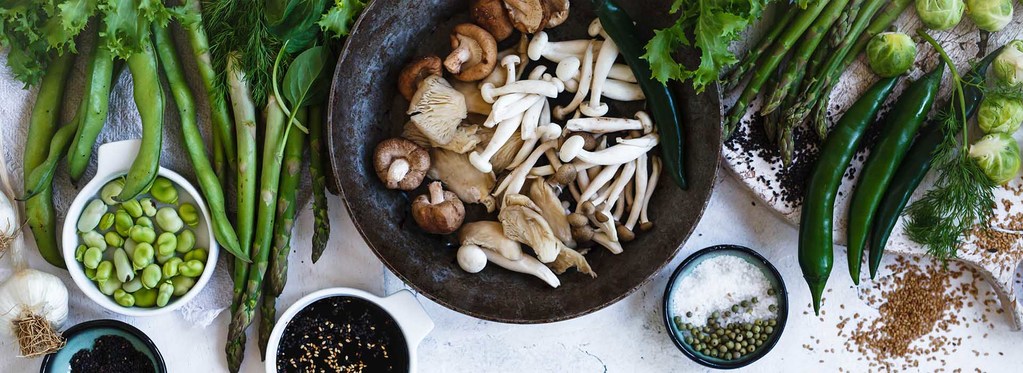Garden mushroom identifier Edible mushroom online in UK
Edible mushroom in UK Neither animals nor plants, fungi are a separate group of organisms.
They can recycle dead and decaying matter, but can also parasitise plants and animals. Usually all we see are the fruiting bodies, which cast spores into the air. and come in various shapes and sizes, helping to identify them.
The British Isles are home to a phenomenal 15,000 species of fungi and wild mushrooms, found in a variety. of habitats but most often in woodlands, fields and grassland. but you may be lucky enough to see some growing in your own garden.
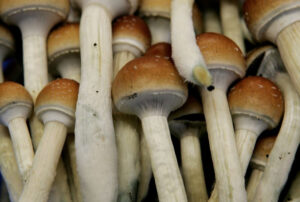
Throughout the autumn spotting, identifying and even foraging wild mushroom is fun to do. Keep your eyes on the ground and you’ll see them popping up through. the leaf litter and grass in a host of shapes and colours. Identification isn’t easy, with many mushrooms having similar, sometimes poisonous. lookalikes so it’s a good idea to use a field guide or mushroom book to help you work out what you see. These are particularly useful if you plan to forage to ensure you’re picking the right ones.
-
How to grow mushrooms
We’ve picked out some of the most common mushrooms you might see in. our garden mushroom identifier below but for further help there are plenty of books available.
Buy mushroom field guides and foraging books on Amazon(Edible mushroom online in UK)
Take a look at some of the UK’s most common native mushrooms. with our detailed garden mushroom identifier.
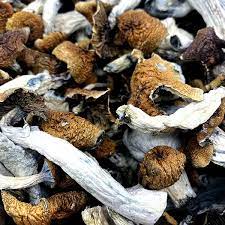
Field mushroom (Agaricus campestris)
Cap: 4-10cm across, convex, domed, expands, smooth white to start, scales peel as it ages.
Stem: short and white, narrows at base.
Ring: thin.
Gills: pink to start, turning chocolate brown to deep black.
Edibility: edible.
Yellow-staining mushroom (Agaricus xanthodermus)
Cap: 8-15cm across, globular at first then broad-domed. white to greyish brown, cracking or becoming scaly.
Stem: white, bulbous at the base.
Ring: broad, hanging off. Flesh turns yellow immediately if bruised.
Gills: pink, turning grey.
Edibility: poisonous.
agaric (Amanita muscaria)
Cap: 8-25cm across, broad dome, bright orange or scarlet, sometimes brownish or yellow. flecked with white warts, though rain can wash these off.
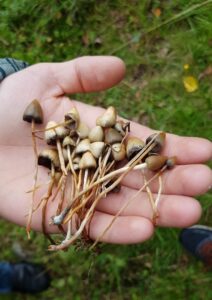
Stem: tall.
Ring: hangs skirtlike.
Gills: white. Often found under birch or pine trees.
Edibility: very poisonous.
Shaggy ink cap (Coprinus comatus)
Cap: 5-15cm wide, pale, scales, bell-like then conical.
Stem: tall (up to 20cm) and narrow.
Gills: white, then pink, then dissolving to drip black ‘ink’.
Edibility: edible, tasty when young (before ink). but if consumed with alcohol produces mild poison.
Fairy ring mushroom (Marasmius oreades)
Cap: 2-5cm across, pale brown convex dome. becoming floppy, with edges wrinkled or grooved.
Stem: narrow.
Gills: whitish. Occurs in large, expanding rings in lawns.
Edibility: edible, but can be confuse with other, poisonous, species.
Sulphur tuft (Hypholoma fasciculare)
Cap: 4-8cm across, convex, or domed, bright sulphur yellow with orange tints and a brown centre.
Gills: yellow, then green and brown.
Stem: long and fibrous. Sprouts in large tufts, with often hundreds of caps, from tree stumps and logs.
Edibility: inedible.
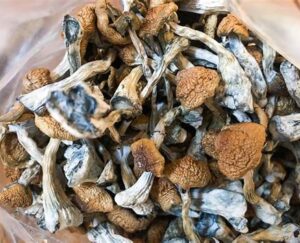
Common ochre russula (Russula ochroleuca)
Cap: 4-10cm wide, dull beige-yellow, convex when young. expands to flat top, becomes wrinkled or ridged at edges.
Gills: brittle, white or cream.
Stem: soft, often hollow.
Edibility: edible but not especially flavoursome.
Liberty cap (Psilocybe semilanceata)
Cap: 1-2cm wide, conical, pale brownish-yellow with greenish tints. often slimy, edges rolled under when young.
Gills: dark purple-brown.
Stem: tall, thin, wavy, white.
Edibility: inedible and hallucinogenic, this is also known as magic mushroom.
Giant puffball (Calvatia gigantea)
Up to 1m wide, but usually 20-50cm. round, flesh is white then yellowish, with thick, smooth. white skin that splits across the dome to emit clouds of brown spores.
Edibility: edible when young, before spores form.
Many thanks to Chris Shields for providing. the beautiful illustrations used in this feature.
Mushroom foraging
Spending a couple of hours foraging for mushrooms is fun and rewarding. but stick to the rule that if you are certain of a mushroom’s identity, then do not pick it or consume it. It’s best to cook all wild mushrooms before eating as only a few are safe to eat raw. Ensure you only pick where you can leave plenty for wildlife and always. avoid picking any rare, protected fungi.
Safest wild edible mushrooms
-
Giant puffball (Calvatia gigantea
-
Hedgehog fungus (Hydnum repandum)
-
Wood ears (Auricularia auricula-judae)
-
Scarlet elf cups (Sarcoscypha coccinea)
-
Cauliflower fungus (Sparassis crispa)
-
Field blewits (Lepista personata
-
Porcini (Boletus edulis)
-
Oyster mushroom (Pleurotus ostreatus)
-
onditions
-
Discover
-
Plan
-
Connect
NUTRITION
-
Special Diets
-
Healthy Eating
-
Food Freedom
-
Conditions
-
Feel Good Food
-
Product
-
Vitamins & Supplements
-
Sustainability
-
Weight Management
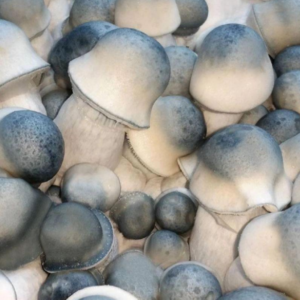
THE SUSTAINABLE TABLE
NUTRITION
Evidence Based
3 Edible Wild Mushrooms (And 5 to Avoid)
-
Hen-of-the-woods
-
Oyster
-
Sulphur shelf
-
Mushrooms to avoid
-
Tips
-
Bottom line
Throughout history, people around the world have foraged wild mushrooms for food.
Gathering wild mushrooms can also be an rewarding and interesting hobby. But, those who do it must proceed with the utmost caution.
Though many wild mushrooms are nutritious, delicious, and safe to consume. others pose a serious risk to your health and can even cause death if ingested.
For this reason, it’s critical to only hunt mushrooms with someone who’s. experienced at identifying both edible and poisonous mushrooms. Edible mushroom online in UK
This article lists 3 edible wild mushrooms, as well as 5 poisonous mushrooms to avoid.
1. Hen-of-the-woods
Grifola frondosa known as hen-of-the-woods or maitake is an edible mushroom that’s a favorite of mushroom hunters.
Growth
Hen-of-the-woods is a polypore — a type of fungus that has small pores covering its underside.
They grow on the bases of trees in shelf-like clusters, favoring hardwoods like oak. These clusters resemble the tail feathers of a sitting hen hence the name “hen-of-the-woods.” Several hen-of-the-woods may grow on a single tree.
This mushroom is native to China but also grows in Japan and North America. especially the northeastern United States. It’s a perennial mushroom and often grows in the same spot for many years.
Identification
Hen-of-the-woods are grayish-brown in color, while the underside of the caps and. branch-like stalk are white, though coloring can vary.
These mushrooms are most found in the fall, but they can found less in the summer months as well (2).
Hen-of-the-woods can grow quite large. Some mushroom hunters have scored massive mushrooms weighing. up to 50 pounds (about 23 kg), but most weigh 3–15 pounds (1.5–7 kg) (3).
A helpful clue when identifying hen-of-the-woods is that it does not have gills. and the underside of its cap has tiny pores, which are smallest at the edges.
Don’t eat older specimens that are orange or reddish in color, as they may be contaminate with bacteria or mold.
Hen-of-the-woods is often favored by beginner mushroom hunters. It’s distinctive and does not have many dangerous look-alikes, making it a safe option for novices.
Nutrition
Hen-of-the-woods are quite nutritious and particularly high in the B vitamins folate. niacin (B3), and riboflavin (B2), all which are involve. in energy metabolism and cellular growth (4Trusted Source, 5Trusted Source).
This mushroom also contains powerful health-promoting compounds, including complex carbohydrates called glucans.
Glucans isolated from hen-of-the-woods have shown to have immune. boosting properties in animal studies (6Trusted Source).
What’s more, research shows that these mushrooms may have anticancer. cholesterol-reducing, and anti-inflammatory properties (7Trusted Source, 8Trusted Source, 9Trusted Source).
Hen-of-the-woods have a savory, rich flavor and are delicious when added. to stir-fries, sautées, grain dishes, and soups.
SUMMARY Popular among novice mushroom hunters. hen-of-the-woods found growing at the base of an oak tree. They are grayish-brown in color and resemble the ruffled tail feathers of a sitting hen.
2. Oyster mushroom
The oyster mushroom (Pleurotus ostreatus) is a delicious edible mushroom. that resembles an oyster in shape and is sought after by mushroom hunters.
Growth
Oyster mushrooms grow in forests around the world, including throughout North America.
These mushrooms grow on dead or dying hardwood trees like beech and oak trees. They can sometimes found growing on fallen branches and dead stumps.
Oyster mushrooms decompose decaying wood and release nutrients into the soil. recycling nutrients to be use by other plants and organisms in forest ecosystems.
They can found during the spring and fall months. in the Northern United States and year-round in warmer climates.
Identification
Oyster mushrooms grow in clusters resembling shelves on dead or dying hardwood trees.
Depending on the time of year, the tops of the oyster-shaped caps of these mushrooms. can range from white to brownish-gray and are 2–8 inches (5–20 cm) wide.
The undersides of the caps are covere with spaced gills that run down the stubby. sometimes nonexistent, stem and are white or tan in color.
Oyster mushrooms can grow in large numbers. and many different clusters can found on the same tree.
Nutrition
Oyster mushrooms have thick, white, mild-tasting flesh that contains a variety of nutrients. They are particularly high in B vitamins, including niacin (B3. and riboflavin (B2), as well as the minerals potassium, copper. iron, and zinc
They also contain powerful anti-inflammatory plant compounds, including triterpenoids. glycoproteins, and lectins, which may offer some protection against chronic disease
For example, test-tube research shows that oyster mushrooms have properties. that help fight prostate colon, and breast cancer cells. But, human studies are lacking
Oyster mushrooms are excellent sautéed with onions and garlic as a side dish. You can also add them to soups, pastas, and meat dishes.
SUMMARY Oyster mushrooms can found on dead or dying hardwood trees around the world. They have a mild taste and contain and plenty of nutrients.
3. Sulphur shelf mushroom
Share on Pinterest
The sulphur shelf (Laetiporus sulphureus) mushroom. is also known as chicken-of-the-woods or chicken mushroom. It’s a bright orange or yellow mushroom with a unique, meaty flavor.
Growth
These mushrooms can either act as parasites on living or dying trees. or derive nutrients from dead trees, such as rotting tree stumps.
Sulphur shelf mushrooms grow on trees in shelf-like clusters. They are foun on large oak trees and harvested during the summer and fall months.
It should be note that sulphur shelf look-alike Laetiporus species exist. They grow on conifer trees should be avoide. as they can cause severe allergic reactions in some people.
Identification
Sulphur shelf mushrooms are orange or yellow in color and grow in overlapping shelf-like. clusters on hardwoods, such as oak, willow, and chestnut.
The caps of the mushroom are fan-like or semicircular in shape and 2–12 inches (5–30 cm) across and up to 8 inches (20 cm) deep. The sulphur shelf does not have gills, and the underside of the caps is covere with tiny pores.
Nutrition
Like most mushrooms, sulphur shelf mushrooms are low in calories. and offer a good amount of nutrients, including fiber, vitamin C, potassium. zinc, phosphorus, and magnesium.
Sulphur shelf mushrooms also contain plant compounds, including polysaccharides. eburicoic acid, and cinnamic acid. They have shown to have antifungal. tumor-inhibiting, and antioxidant properties in test-tube and animal studies.
Sulphur shelf mushrooms should eaten cooked — not raw. You can bring out their meaty texture and hearty flavor. by sautéing them with butter, adding them to vegetable dishes, or mixing them into omelets.
Poisonous mushrooms to avoid
Though many wild mushrooms can be enjoye, others pose a threat to your health.
Never consume the following mushrooms:
-
Death cap (Amanita phalloides). Death caps are among the most poisonous of all mushrooms and. responsible for the majority of mushroom-related deaths worldwide. They grow in many countries around the world (22Trusted Source).
-
Conocybe filaris. This mushroom grows in Europe, Asia, and North America and contains the same toxins as the death cap. It has a smooth, cone-like cap that is brownish in color. They are toxic and can be fatal if ingested (23Trusted Source).
-
Autumn skullcap (Galerina marginata). Also known as the “deadly Galerina,” autumn. skullcaps are among the most poisonous of mushrooms. They have small, brown caps and grow on rotting wood
-
Death angel (Amanita ocreata). Related to the death cap, the death angel grows along the West Coast of the United States. This mushroom is white and can cause severe illness and death if eaten.
-
False morels (Gyromitra esculenta and Gyromitra infula). These resemble edible true morels, making them especially dangerous. Unlike true morels, they are not completely hollow when cut.
too the mushrooms listed above, many more types of poisonous mushrooms exist.
If you are ever unsure whether a wild mushroom is edible, do not eat it. Some mushrooms can cause severe sickness and even death.
A popular saying among mushroom hunters is. “There are old mushroom hunters, and there are bold mushroom hunters. There are no old, bold mushroom hunters!” Edible mushroom online in UK
SUMMARYThere are many types of poisonous wild mushrooms that should be avoided. Never eat a mushroom that you aren’t completely sure is edible.
Edible mushroom tips and precautions
For your safety, it’s critical that you only hunt mushrooms if you are experience. in identifying edible varieties. Edible mushroom online in UK
If you’re interested in mushroom hunting, sign up for a class taught by a mushroom expert. to learn how to identify safe varieties. Classes are offere through colleges, universities, and mycology clubs. such as the North American Mycological Association.
It should be note that it’s a bad idea to consume wild edible mushrooms that grow. in urban settings, along busy highways, or in areas where pesticide exposure is likely. Fungi absorb pollutants like car exhaust and chemicals from the environmen Edible mushroom online in UK
When foraging for mushrooms, always bring along a mushroom hunting. guide that includes edible mushrooms that grow in your area. It will help you identify safe varieties.
Always avoid picking edible mushrooms that are past their prime. Signs that a mushroom should not be picke. include decaying flesh, insect infestation, or a rancid smell.
When you’re mushroom hunting, bring along either a basket, mesh bag, paper ba. or small backpack to store your haul, along with a small knife to harvest mushrooms.
Cleaning and storage
Advice on whether to clean wild mushrooms by running them under cool water. and removing excess dirt with a soft brush varies.
Some experts insist that washing mushrooms before storage leads to quicker spoilage. while some foraging enthusiasts recommend cleaning mushrooms before refrigerating them.
Regardless of whether you clean your mushrooms before storing them. keep them in a container with good airflow, such as a paper bag. Do not store mushrooms in plastic bags or sealed containers.
Fresh, wild mushrooms should last a few days in the refrigerator. They can also be frozen or dried, which can increase their shelf life.
SUMMARY Only hunt mushrooms if you are traine in identifying edible varieties. Avoid mushrooms that grow in polluted environments or are past their prime. Fresh, wild mushrooms can be refrigerate, frozen, or dried.

